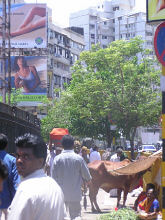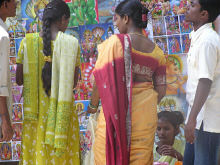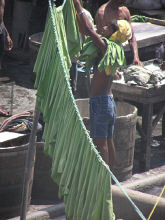Bombay & Mumbai; A Tale of Two Cities
Bombay and Mumbai, India
Bombay begins with a pre-dawn road-trip through streets carpeted with sleeping people. Our yellow and black taxi barrels along in the fast lane, horn blaring as we progress in a succession of rapid braking and momentum-gathering acceleration. Occasional figures wander through the half-light, their expressionless faces momentarily lit up by our headlights. Others try to sleep beside the road, only a strip of cardboard or material between them and the asphalt, limbs flung in all directions. The driver reaches for matches on the dashboard beside a colorful plastic statue of Ganesha, the elephant god of success and destroyer of obstacles, and lights a thin bidi cigarette. He winds down the window and rests his arm on the clunky metal door, letting in cool air and the worn-in smell of the city.


People bringing cows into the city
![]()
![]() The few people we’d seen sleeping beside the road turn into large groups under the shelter of an incomplete overpass that runs parallel above us. In places they lay side by side, occupying a division between the lanes that’s barely longer than their bodies. An old bus spews thick fumes towards whole families beneath coarse blankets. One man lies on a slab of concrete, his arm overhanging the road, his fingertips almost touching us as we pass by.
The few people we’d seen sleeping beside the road turn into large groups under the shelter of an incomplete overpass that runs parallel above us. In places they lay side by side, occupying a division between the lanes that’s barely longer than their bodies. An old bus spews thick fumes towards whole families beneath coarse blankets. One man lies on a slab of concrete, his arm overhanging the road, his fingertips almost touching us as we pass by.
Some are construction workers, building roads and houses but have nowhere to live themselves. Some are from the countryside where a drought has lead to the starvation or suicide of 4,000 farmers in the past year. Bombay is booming, said to grow at a thousand people a day. Its outer suburbs are littered with hundreds of half complete high rise apartments where the middle-class can live, and pay for, the dream. The first impression, however, is of the millions of homeless that dream of better days to come.
The doors of six by twelve foot makeshift houses open to the first rays of dawn. Men in underwear lather themselves with soap and rinse from a bucket. Women in red saris crouch by gas lit stoves, clutching at their children who look wide-awake and ready to play on the highway pointing towards the city. As for me, I’m looking forward to finally arriving, and getting some sleep on a hotel bed.
Delhi may be the centre of government and arts, Bangalore’s the IT boom town, Calcutta the centre of the old Raj, and Chennai the location of the booming Business Process Outsourcing sector, but Mumbai is still the financial and glamour capital that inspires India to dream of the good life. If you can make it there, you can make it anywhere.
Half of Mumbai’s fifteen million people stream into the city’s offices from the outlying suburbs each day. Built around a harbor, it accounts for almost half of India’s international trade and tax revenue, but was once only the dowry of a Portuguese princess, who married Charles II of England in 1661. The British corrupted the Portuguese name of “Bom Baia”, meaning “Good Bay”, into Bombay. Over three hundred years later, in 1995, it was renamed Mumbai, after the local deity Mumbadevi, but “Bombay” is still widely used among the large English speaking population.
A few hours later, a stroll from my Colaba hotel takes me down a seaside promenade that leads to the Gateway of India. It commemorates “the landing in India of their Imperial Majesties King George V and Queen Mary” in 1911, and was the place where the last Englishmen formally quit India in 1947. Opposite sits the Taj Mahal Hotel, built by the Parsi industrialist Jamshedji Tata as a magnificent come-back after he was refused into a hotel with a whites-only policy. Around the corner is the Colaba Causeway. It’s now a shopping district and home to Leopold’s Café, a key location in Greg Roberts’s Shantaram, a remarkable tale of life in Bombay. Two years ago, I found a week’s work on the Causeway as a policeman in a Bollywood movie, but I’m here to contemplate some more remote history. In 1838, it was here that land reclamation joined the island of Colaba to the mainland, one of seven former islands that now make up the heart of the city.
Outside a barista, I watch as a street vendor knocks the top of a coconut with a machete before handing it to me complete with a straw. Refreshed, I cross over to the Prince of Wales Museum and stand, with an audio tour’s commentary running though my headphones, in front of four-thousand-year-old figurines from the Indus Valley. Jewel studded daggers, jade snuff boxes and ornate hooker opium pipes progressively work back to a more modern age. Across the road, the Jehangir Art Gallery provides a less crowded, air-conditioned respite from the heat and bustle, and a range of contemporary paintings with a mixture of international and traditional Indian influence. The quarterly Art India magazine for sale there has details of artists and the many dealer galleries across the city.


Colourful Women
![]()
![]() A five dollar return taxi ride takes a fifteen kilometre circuit up to Malabar Hill overlooking Chowpatty Beach, which looks best from a distance, and on to the Dhobi Ghat where thousands of pieces of clothing are sent each day to be washed and dried. Devout Hindu worshippers stream into nearby Mahalaxmi Temple, built overlooking the ocean. Women stream in with bright yellow offering garlands over their kaleidoscopic clothing past the beatific blue figures of Krishna and Shiva; the gods must be colourful to compete with the women.
A five dollar return taxi ride takes a fifteen kilometre circuit up to Malabar Hill overlooking Chowpatty Beach, which looks best from a distance, and on to the Dhobi Ghat where thousands of pieces of clothing are sent each day to be washed and dried. Devout Hindu worshippers stream into nearby Mahalaxmi Temple, built overlooking the ocean. Women stream in with bright yellow offering garlands over their kaleidoscopic clothing past the beatific blue figures of Krishna and Shiva; the gods must be colourful to compete with the women.
Heading back towards Fort, the commercial district, I pass the gothic glory of Victoria Terminus, and walk the last stretch through Georgian architecture that wouldn’t be out of place in London. The bleached white St Thomas’s Church, backed by the towering stock-exchange and its accompanying suits, orientates me. I’ve made it in time for a lunch of masala dosa’s (rice and lentil pancakes fried in ghee and stuffed with spicy vegetables) with a friend originally from Rajasthan.
“I’ll show you the real Bombay,” says Rohit, a writer and columnist with Mumbai’s largest daily newspaper.


Dhobi wallah at the Dobhi Ghats
![]()
![]() I’m a little wary, as I heard this phrase from a journalist the last time I was in Mumbai and ended up in a roadside strip bar. Well, the Indian version of a strip bar, where young women dance half-remembered Bollywood routines in flowing saris with only their stomachs bared, watched with casual enthusiasm by groups of men drinking and smoking at encircling tables.
I’m a little wary, as I heard this phrase from a journalist the last time I was in Mumbai and ended up in a roadside strip bar. Well, the Indian version of a strip bar, where young women dance half-remembered Bollywood routines in flowing saris with only their stomachs bared, watched with casual enthusiasm by groups of men drinking and smoking at encircling tables.
“Pria’s got an invite to a gallery opening in Colaba, and Friday’s good at Velocity, one of Bombay’s biggest nightclubs.”
Pria, a Goan born painter, writer and stylist for ‘India’s classiest men’s magazine’, changed the spelling of her name when an Israeli friend told her the ‘y’ in Priya seemed redundant. Well, at least it’s phonetically manageable, unlike the vowel phobic character in a Douglas Copeland book who changed her name to ‘Shw’. It’s an excess of vowels that will provide the challenge at Raghava Kalyanaraman’s exhibition, though he also calls himself K.K. My award for “close call with a long name”, however, goes to the esteemed Bureau Chief of The Pioneer, a newspaper established in 1864 and a former employer of R. Kipling and W. Churchill – Mr. Theriyur Narayan Sastry Raghunatha, who thankfully insisted I call him Raghu.
That evening we enter a familiar piece of Colaba, an area of town that’s part expensive inner-city pad, part backpacker dive and part gentrifying bohemia. Slipping behind the Radio Club, opposite the India Ocean, we made our way into a swanky courtyard complex of boutique clothing stores. Walking into the Ashish Balram Nagpal Art Gallery we’re confronted by a high society scene that’s an instant form of reverse culture shock after acclimatizing to Bombay’s street level culture. The room’s packed with exquisitely dressed people, and within seconds Rohit’s introducing me to a stunningly beautiful green eyed model with a spotlight bright smile.
K.K is dressed in a regal, deep red full-length outfit, and with knowing eyes and smooth skin he has the appearance of a boy king, or a boy maharaja. Although only in his early twenties, he’s been exhibiting for six years. He tells me, in a gentle voice, that though he grew up in Bangalore he now lives in Cambridge, Massachusetts. I point out my favorite painting, a red dancer painted, like all his work, with his hands. “Inspired by flamenco on a trip to Barcelona,” he says.
Photographers circle the guests, taking shots of people who are famous to everyone in the room but me. I start a conversation with a woman about writing, who I’m later told is a TV icon, but back out when she mentions her friends Salman (Rushdie) and Vikram (Seth), and end up in a slightly drunken twenty minute conversation (an eternity in the world of mingling) about Vipassana meditation with a woman just returned home to Mumbai after eighteen years in San Francisco.
The crowd starts to thin as K.K. farewells his guests, turning to me to roll his eyes and mutter “ah, publicity” under his breath before turning back on the charm.
Rohit’s made friends with an outgoing gold dealer, and soon we’re piling into the back of his car. He drops us off outside VeloCity, into a sea of glammed up people congregating outside this Friday night Mecca of clubland. Pria marches on saying, “I can get in the back way.” We up follow her up a set of stairs where she stops to talk to someone I recognize as familiar, and as he’s saying goodbye I put the pieces together – Pria confirms he’s Cyrus, an MTV VJ. We make it into the VIP lounge. It’s the caste system of cool. The club’s 18,000 square feet is spread over four large rooms, with this one overlooking the main dance floor. We stroll through the ‘too hip to dance’ crowd, with Pria stopping along the way to talk to male models who are six foot four and full of muscles. Rohit supplies the vodka and after an ear-splitting attempt at conversation, and more vodkas, we descend into the masses.
We squeeze through retro and funk rooms, carving out just enough room to dance, before heading into the huge main dance floor, packed with a few thousand people. Occasional white faces pepper the crowd, but it’s mainly Bombay’s middle to upper dance class, and the vibe isn’t dissimilar to a club like Home in Sydney, or some of the more commercial clubs in London. No bare-stomached saris here; this is the MTV generation, part of the global village where the demographic overrides the location. The music is eclectic; Indian Bhangra and Dhol dance music alternates with House, Drum & Bass and Hip-Hop. A UK DJ takes over the decks and the international metropolitan melting pot is complete.
Rohit is lost in the crowd and Pria and I dance, enjoying the more casual downstairs atmosphere, away from the serious business of seeing and being seen. By the time the sweat and exertion has taken the edge off the vodka energy rush, Rohit returns with news of a friend. It’s near 2 a.m. as we stride out of the club on a mission, rounding up the crowd for the after hours session. We pass through a couple of smaller bars, each one packed full of the Beautiful People dancing and drinking. I’ve seen so few of these kinds of people on the streets of Bombay that they truly seem to be creatures of the night.
Rohit’s friend turns out to be Jazz, a charismatic Sikh in his mid-fifties. We speed along an uncharacteristically empty Marine Drive in his sleek late model car, the stereo pumping out dance tunes. Another full car, driven by a Spanish designer who divides his time between New York and Mumbai, follows us to another club we’ve heard has paid off the police so it can stay open till dawn. But by the time we get there a loose crowd of women in high-heels and policemen with truncheons tells us we’re too late. We turn around and head back to the inner sanctum.
Jazz’s spacious apartment, with glass walls giving views across the water, becomes our dimly lit crash pad. He fires up a huge plasma screen hooked to an impressive stereo and computer, and pulls out a stack of DVDs taller than his six-foot frame. Every disc is a live recording, mainly blues and rock from musicians more influential than popular. I select a few tracks from the massive range. John Mayall sings the blues and the crowd cheers in awesome high definition sound as we drink and sift through the collection, picking out a list of must-play tunes that keep us going until sunshine begins to invade the sanctum.
Finally staggering out onto the street, the exhilaration of the evening turns into a smiling, humming exhaustion. We hail a cab and begin a dawn road trip through streets carpeted with sleeping people.
Check out Will’s book “The Highway“, which was published in India in June 2004.
Zac Goodman disappears while paragliding in the Himalaya. The only clue his companion finds to aid his search is a manuscript describing their motorcycle journey from the Himalaya, to mystical encounters in the sacred cities, and on a violent reunion in Goa.
Set entirely in India, The Highway takes a lucid, otherworldly trip to the end of the road. For more info please see www.willmarks.com.